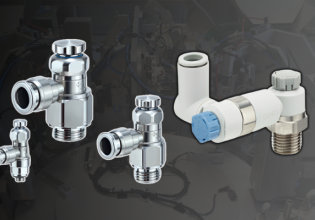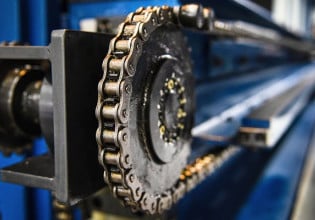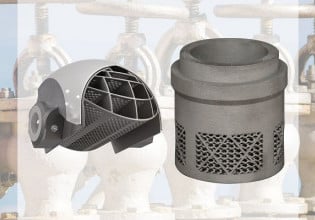Omron PLCs - A Hardware History
With the first fuzzy logic-based controllers on the market in 1983, learn how the Japanese-born automation company, Omron, adopted fuzzy logic as a basis for the design of its current PLCs.
Omron is a major electronics and automation company with a long history in its home country of Japan. The company holds the largest share of the control and automation equipment market in Japan, and its products have found success in many other countries. Besides programmable logic controllers (PLCs), Omron is an important manufacturer of healthcare equipment, appliances, and automotive components.

Figure 1. Omron Automation is a Japanese-born automation and electronics company that first entered the PLC market in the 1970s. Image used courtesy of Omron
Omron entered the PLC market in the 1970s, and the company sought to differentiate itself from its competitors from the start. In the previous decade, Omron invested heavily in developing new technological concepts. In 1967, the company introduced the theory of SINIC (Seed-Innovation to Need-Impetus Cyclic Evolution). SINIC theory posited that society, science, and technology are connected in a way that one of these areas motivates the evolution of the other two cyclically.
Sysmac: Omron's First PLC
SINIC theory was the driving concept behind the development of the first Omron PLCs in the 1970s. At the time, the manufacturing industry was being affected by changes in society, where the market shifted toward consumption of more personalized goods. This change led to production processes having to increase flexibility while keeping high rates of production. Omron quickly responded and launched the Sysmac PLC. The Sysmac came with fast processing speeds and introduced the sequence programming style.

Figure 2. The Sysmac was the first PLC launched by Omron. Image used courtesy of Omron
Years later, in the 1980s, Omron shifted its attention to another innovative concept, called fuzzy logic. Fuzzy logic incorporates the ambiguities of the physical world into mathematical logic. While in Boolean logic, things can only be true or false, or in other words, have a value of 0 or 1, in Fuzzy logic, any value between 0 and 1 is accepted. In fuzzy logic, things can be 100% true (1) or 100% false (0), but they can also be partially true and partially false.
Omron launched C-Series controllers in 1983—the first fuzzy logic-based controllers on the market. In general terms, in the PLC world, fuzzy logic means that the controller can understand and make decisions in ambiguous scenarios. It resembles how a human would have made decisions under the same circumstances and given partially complete data.
Omron followed the success of the first controllers with the launch of new iterations in the C-Series, including the fastest fuzzy controller in the world in 1987 and the fastest fuzzy logic computer chip in 1988. From then on, the company fully adopted fuzzy logic as a basis for the design of many of its current products, including PLCs and vision systems.
The C-Series is still alive, and in the following sections, we will review the most popular PLCs in these series and other models.
CS1 PLC
The CS1 PLC series is designed for medium- to large-scale systems, and there are nine controller variants in this current series. These controllers are rack-mounted and can be expanded to up to 80 units, with the option of further expansions through rack extenders.
CS1 PLCs offer improved I/O processing and refresh rates compared to other brands. They also support up to 5,120 I/O points, and with higher processing power, these PLCs are finding success in IoT and industry 4.0 applications.

Figure 3. A CS1H PLC with additional I/O. Image used courtesy of Omron
CS1 controllers support many communication protocols, including Ethernet/IP and serial communication. In addition, the controllers can be configured for duplex operation, providing system redundancy.
Compared with other vendors, the CS1 controllers are generally more cost-efficient. These controllers are suited for vision systems, complex robotics, and advanced motion control applications.
CJ Controllers
The CJ1 and CJ2 PLC families are built for small to medium control applications. The CJ1 line is the predecessor to the CJ2 line, and it still has some PLC models that are actively supported. CJ PLCs support Ethernet-based communication, motion controls, and fast I/O refresh rates.
CJ controllers offer between 5,000 and 50,000 program steps and between 64,000 and 832,000 words of memory. In addition, CJ-based I/O units have fast processing speeds of 20 microseconds for real-time solutions.

Figure 4. A compact CJ2 controller. Image used courtesy of Omron
CJ controllers are suited for small and medium machine automation and robotics applications. In addition, the CJ2H model can support complex functions such as vision systems and advanced motion control.
CP Controllers
CP controllers are in the micro PLC range and are ideal for small machine control and educational purposes. They support four-axis position control and Ethernet-based communication. Expandability is available on a limited scale.
Figure 5. A CP2E microcontroller. Image used courtesy of Omron
NX Controllers
NX is a platform that aims to provide a simplified system architecture with comprehensive machine controller functions. The NX controllers support functionalities for many applications, including robotics, database management, and simulations.

Figure 6. An NX7 controller from Omron. Image used courtesy of Omron
Controller Evolution
Holding Japan's largest market share of control and automation equipment and as a worldwide leader in automation and electronics, Omron's hardware configurations in the past have helped shape their modern offerings and evolved fuzzy logic-based controllers on the market today.
Check out our other PLC Hardware History articles:








Fuzzy Logic is a farce. Closed loop control is all about using the controller to move the open loop poles to new closed loop pole locations that will provide the desired response. I have down loaded many FL documents that compare FL to PID. They are a joke. The show the FL controlling better than the PID but it only shows their ignorance of control. They don’t know how to tune a system using a PID.
https://youtu.be/5389Mh6Xibo
I am not saying that PID is the ultimate control method but when augmented with feed forwards and a Smith Predictor to compensate for dead time, a PID is hard to beat.
There are other methods of control like Neural Nets and Model Predictive control. NNs still need a way to compensate for the dead time. MPC is computationally intensive and requires a good model. My company uses something like NNs to ID food products. It takes a lot of training to train a NN.
MPC requires an accurate model. I have videos about how to compute the models.
FL is on par with Ziegler-Nichols where one tries to control what he doesn’t understand.
One of my favorite quotes.
[quote=Lord Kelvin]
I often say that when you can measure what you are speaking about, and express it in numbers, you know something about it; but when you cannot measure it, when you cannot express it in numbers, your knowledge is of a meagre and unsatisfactory kind.